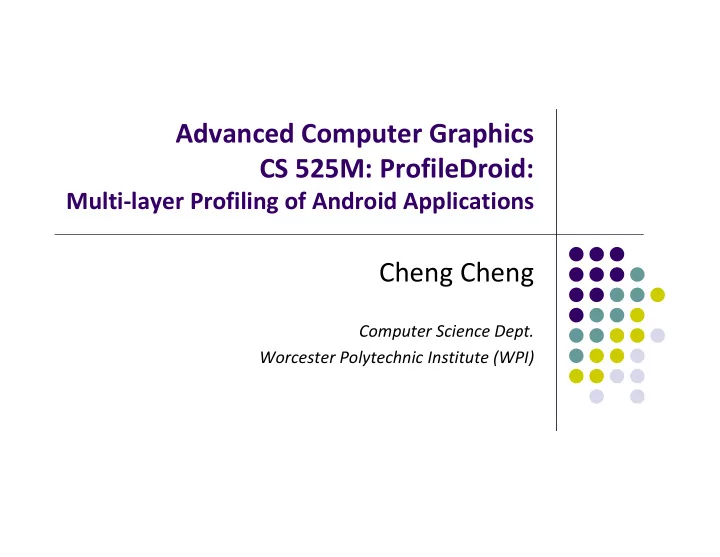

Advanced Computer Graphics CS 525M: ProfileDroid: Multi ‐ layer Profiling of Android Applications Cheng Cheng Computer Science Dept. Worcester Polytechnic Institute (WPI)
Motivation More and more people Android is an very use smartphones important platform
Motivation
Related Work Smartphone Measurements and Profiling do not analyze the Android apps themselves. Android Security Related Work. Static Layer do not include Intent Usage Profiles the app do not from multiple layers Profile the network layer was not with a more fine ‐ grained granularity
Approach Four different layers: (a) static, or app specification (b) user interaction (c) operating system (d) network approach For each layer, the monitoring component runs on the Android device The profiling part runs on the connected computer.
Approach
Experiment Capture ‐ and ‐ replay Round1: Each user ran each app one time for 5 minutes Capture the interaction using event logging Round2: Using replay tools, replay back 5 times in the morning and 5 times at night. (10 runs each per user per app) Round3: Apply the logs for different experiments.
Test Apps
Static Layer (Layer 1) Analyze the APK (Android application package) file Use apktool to unpack the APK file to extract relevant data. Focus on the Manifest.xml file Bytecode files contained in smali folder.
Static Layer (Layer 1) Permissions (shown at install) Internet GPS Camera, Microphone, Bluetooth, Telephony Intent Usage (not shown at install) Resource use without permission via deputy apps
Static Layer (Layer 1) Result:
User Layer (Layer 2) Focus on user ‐ generated events Events result from interaction between the user and the Android device while running the app. Use combination of the Logcat: capture the system debug output and log messages from the app. Getevent(read /dev/input/event*): collect the user input events
User Layer (Layer 2) Focus on TouchScreen Accelerometer Proximity sensor.
User Layer Result(Layer 2)
Operating System Layer (Layer 3) Monitor system calls Strace: collect system calls invoked by the app Classify system calls into four categories: Filesystem Network VM/IPC • Enforces isolation • Overhead: scheduling, idling, IPC miscellaneous
Operating System Layer(Layer 3)
Network Layer (Layer 4) Analyze network traffic by logging the data packets. Tcpdump: collect all network traffic on the device.
Network Layer Result (Layer 4)
ProfileDroid: Profiling apps Extract information from each layer in isolation or in combination with other layers.
Result Free apps are not as free as we might think • 50—100% higher system call intensity • Dramatically higher network traffic (usually ads&tracking) Bad for your dataplan, your battery life, and your privacy VM ‐ based isolation comes at a cost • 64—87% of system calls are due to VM and IPC
Result Apps talk to many servers spread across many top ‐ level domains • AngryBirds$$: 4 domains, AngryBirds free: 8 domains • Weatherbug: 13 domains, Shazam: 13 domains Most network traffic is not encrypted Google traffic is predominant • Except for Amazon and Facebook which have 0 (zero) Google traffic
Future Work Expand study to include more apps User profiles • Study the variance across users Fully automate process Profiler as an app to run on the device • Provide summary of usage on close
References http://www.sigmobile.org/mobicom/2012/slides/Go mez.pdf
Recommend
More recommend